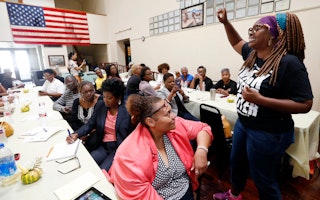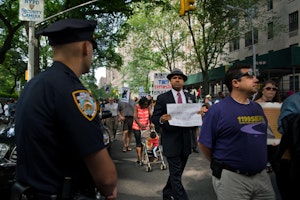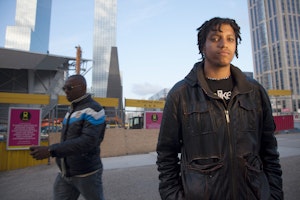Q&A: Bearing Witness to Broken Policing

As people around the world take to the streets to demand racial justice, Iva Dobichina of Open Society’s Human Rights Initiative spoke to Ambika Samarthya-Howard from WITNESS, a nonprofit group that encourages people to use video and technology to defend human rights. They discussed the role video has played in drawing attention to the need for police accountability.
At WITNESS, your slogan is: “See it. Film it. Change it.” How do you think the use of video has influenced the politics of police accountability in the United States?
In 1991, the arrest and beating of Rodney King was caught on camera by a bystander, and the graphic video was broadcast into homes across the nation. The video ignited a national outcry as well as five days of protest against racist and abusive policing. The following year, WITNESS was founded on the promise of video and civic witnessing to make truth visible, secure justice, and mobilize allies for change.
In the years since, demonstrated most recently by the cases of George Floyd, Eric Garner, Walter Scott, Philando Castile, and so many others, video has enabled activists and accidental witnesses across the United States to expose incidents of police violence that would otherwise go unseen. Thanks to technology, especially mobile phones, voices that have historically been ignored, discredited, or exploited are being seen and heard in a new way. In the face of corrupt and unjust systems, videos of police violence make the truth visible; they create a road to true and lasting justice; and they reveal the underlying, systemic nature of structural racism.
What role does WITNESS play?
WITNESS provides guidance and resources that enable people to be safer and more effective when documenting the police and other state forces. We encourage activists and civic witnesses to think about digital and physical security, distribution strategies, and verification.
For example, we tell activists to ensure their phone is set up to back up their media, so that if their videos are deleted, they still have a backup. We encourage people to resist the impulse to release a video in the heat of the moment, instead waiting until after the police report is released to contrast the official narrative. We also recommend working in conjunction with a lawyer or advocacy organization when releasing this kind of footage. Simultaneously, we advocate to technology companies to ensure these platforms are optimized to support, rather than harm, activists using them for human rights.
Recently, WITNESS announced a new People’s Database for Community Police Accountability. What is that, and how will it help?
To expose abuses that don't often capture media attention, WITNESS partnered with Berkeley Copwatch, a local group in Berkeley, California, that observes and reports on police misconduct and violence on the street, to create the People’s Database for Community Police Accountability. The database supports groups to collect, organize, and store documentation of police encounters, so that they can more effectively conduct investigations, coordinate campaigns, and challenge unjust laws and practices.
The database has already made a significant impact on Berkeley Copwatch’s advocacy efforts. UC Berkeley police officer Sean Aranas, for example, was shown to be involved in many separate incidents of gross misconduct—especially against people who are unhoused. He retired within two months of the release of Berkeley Copwatch’s footage, some of which showed him using excessive force.
Without this plan and framework to organize the footage collected by grassroots groups, it simply lays forgotten on a hard drive somewhere. The People’s Database presents a user-friendly methodology for grassroots groups to collect, maintain, and retrieve information in order to keep their communities safe.
What do databases like these show?
WITNESS seeks to challenge the mainstream narrative of police abuse as the work of “one bad apple” so we can begin to explore deeper issues of systemic abuse and impunity. Civic documentation has a crucial role to play in demonstrating these patterns. In order to demonstrate patterns of abuse, grassroots groups need to be able to film incidents, as well as find and aggregate the footage in ways that can push for accountability.
Although many of the videos collected in the People’s Database don’t depict crimes as egregious as assault or murder, in aggregate, they help expose the day-to-day pressure, surveillance, and harassment that residents in heavily-policed neighborhoods—predominantly residents of color—face on a regular basis. At the hands of the police, marginalized communities are subject to illegal searches, punitive destruction of property, racial profiling, illegal towing, as well as instances of unnecessary force.
Systemic patterns of enforcement require that groups be able to substantiate their concerns with aggregated footage and be able to gather all of this information together in an organized and comprehensive way, often quickly. Through the indexing and analysis of more than hundreds of videos filmed by members of the community, it becomes possible to identify officers who repeatedly abused members of the community they were meant to serve.
The database is not public, correct? Why not?
The People’s Database is not intended to be put online or made public, due to privacy and security issues. It was developed to primarily serve as an internal resource for the group, and the information will be used for organizing purposes and shared with trusted sources and Berkeley community members upon request.
A primary goal of this project, and others like it, is to develop a way to collect, curate, analyze, and preserve large collections of videos documenting police abuse. The goal here is to take an often-large amount of footage and organize it in a way that can be used to spot patterns and develop a deeper understanding of the way police use their power in a particular community.
WITNESS is a grantee of the Open Society Foundations.


